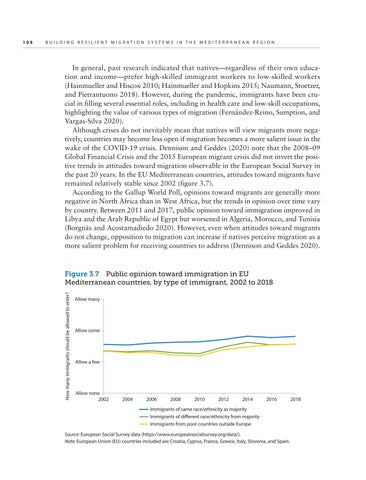B U ILDING RESILIENT MIGR A TION S Y STEMS IN T H E MEDITERR A NE A N REGION
In general, past research indicated that natives—regardless of their own education and income—prefer high-skilled immigrant workers to low-skilled workers (Hainmueller and Hiscox 2010; Hainmueller and Hopkins 2015; Naumann, Stoetzer, and Pietrantuono 2018). However, during the pandemic, immigrants have been crucial in filling several essential roles, including in health care and low-skill occupations, highlighting the value of various types of migration (Fernández-Reino, Sumption, and Vargas-Silva 2020). Although crises do not inevitably mean that natives will view migrants more negatively, countries may become less open if migration becomes a more salient issue in the wake of the COVID-19 crisis. Dennison and Geddes (2020) note that the 2008–09 Global Financial Crisis and the 2015 European migrant crisis did not invert the positive trends in attitudes toward migration observable in the European Social Survey in the past 20 years. In the EU Mediterranean countries, attitudes toward migrants have remained relatively stable since 2002 (figure 3.7). According to the Gallup World Poll, opinions toward migrants are generally more negative in North Africa than in West Africa, but the trends in opinion over time vary by country. Between 2011 and 2017, public opinion toward immigration improved in Libya and the Arab Republic of Egypt but worsened in Algeria, Morocco, and Tunisia (Borgnäs and Acostamadiedo 2020). However, even when attitudes toward migrants do not change, opposition to migration can increase if natives perceive migration as a more salient problem for receiving countries to address (Dennison and Geddes 2020).
Figure 3.7 Public opinion toward immigration in EU Mediterranean countries, by type of immigrant, 2002 to 2018 How many immigrants should be allowed to enter?
108
Allow many
Allow some
Allow a few
Allow none 2002
2004
2006
2008
2010
2012
2014
2016
Immigrants of same race/ethnicity as majority Immigrants of different race/ethnicity from majority Immigrants from poor countries outside Europe Source: European Social Survey data (https://www.europeansocialsurvey.org/data/). Note: European Union (EU) countries included are Croatia, Cyprus, France, Greece, Italy, Slovenia, and Spain.
2018

